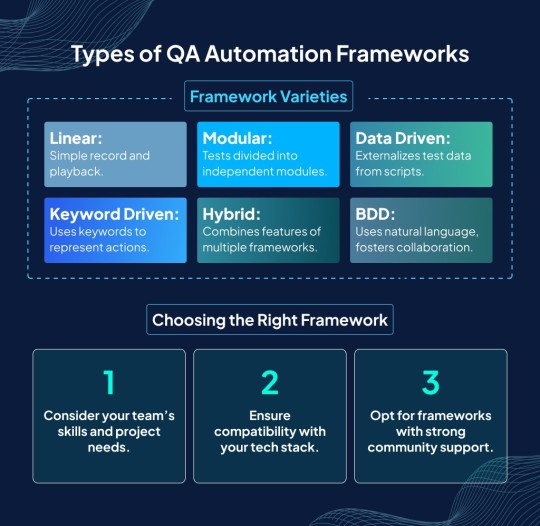#automation testing frameworks
Explore tagged Tumblr posts
Text
Types Of Popular Test Automation Tools or Frameworks: Optimizing Software Testing Efficiency

Introduction
In today’s fast-paced software development landscape, the need for efficient and effective QA Software Testing Services methodologies is paramount. Test automation frameworks have emerged as indispensable tools for streamlining testing processes, enhancing productivity, and ensuring the quality of software applications. In this comprehensive guide, we will explore various test automation frameworks, including Selenium, Appium, Cypress, and more, to help you make informed decisions in your testing endeavors.
Read More
#software testing services#software testing company#automation testing tools#automation testing frameworks#qa software testing services#qa software testing company#software testing
0 notes
Text
Best Practices for Designing a Test Automation Framework
Designing a robust test automation framework is essential for scalable, maintainable, and efficient testing. A well-structured framework helps teams standardize test processes, accelerate execution, and improve code reusability. Here are key best practices to follow:
Define a Clear Architecture
Choose a layered structure that separates test scripts, utilities, and test data. This modularity improves maintainability and enables easy updates.
Select the Right Tools and Tech Stack
Choose tools that align with your application, team skillsets, and CI/CD goals—like Selenium, TestNG, Cypress, or Playwright. Integrate with version control and build tools for automation framework continuity.
Use Data-Driven and Keyword-Driven Approaches
Implement reusable test logic that supports parameterization. This reduces redundancy and allows flexibility in running tests with various datasets.
Enable Logging, Reporting, and Exception Handling
Build in detailed logs and custom reports for quick debugging. Include robust error handling to prevent script failures from breaking the entire suite.
Ensure Scalability and Maintainability
Design the framework to scale with your application. Follow coding standards, comment code clearly, and regularly refactor for performance.
A well-designed framework is the foundation for long-term test automation success.
#AI test automation#tcoe testing#test management tools#qa test management tools#automation tools for testing#performance testing tools#open source testing#web automation using robot framework#test automation strategy#testing coe framework
0 notes
Text

Full Stack Software Testing is a comprehensive approach that involves testing both the front-end (UI) and back-end (server, database, APIs) of a software application. It includes manual testing, automation testing (using tools like Selenium), API testing, performance testing, and database validation. Full stack testers have a complete understanding of the software architecture, which enables them to ensure quality at every layer of the application.
Naresh i Technologies offers industry-oriented Full Stack Software Testing training with real-time projects, expert faculty, and placement assistance to help students become skilled and job-ready professionals.
#selenium#manual#automation#softwaretesting#jira#corajava#webservices#frameworks#seleniumwebdriver#course#cucumber#testing#software#learning#training
0 notes
Text
0 notes
Text
Automation vs. Manual Testing – Which One Do You Need?
When it comes to software testing, choosing between automation and manual testing can be challenging. Both have their advantages, and at Quality Professionals, we help businesses find the perfect balance between the two.
Manual testing is ideal for exploratory, usability, and ad-hoc testing, where human intuition and creativity are essential. On the other hand, automation testing is perfect for repetitive tasks, regression testing, and performance evaluations, saving time and increasing efficiency.
A successful QA strategy incorporates both approaches to ensure software reliability, speed, and cost-effectiveness. Not sure which testing method suits your project? Let’s discuss your needs and create a customized QA plan for your business. Reach out to Quality Professionals today!
#mobile app testing services#software testing services#software quality assurance#quality assurance software#qa consulting companies#software companies#software quality consultants#automating testing#quality assurance framework#software
1 note
·
View note
Text
#Advantages of API testing#API testing best practices#API testing implementation approaches#API testing methodologies#API testing strategies 2025#Benefits of automated API testing#Implementing API testing frameworks
0 notes
Text
JavaScript Testing Best Practices: Frameworks for Success

Unlock the secrets to successful JavaScript testing with our detailed infographic! From unit testing in JavaScript to the most effective frontend testing frameworks, this visual guide showcases the top JavaScript testing frameworks, libraries, and best practices to ensure robust and efficient test automation.
#JavaScript Testing Frameworks#JavaScript Test Automation#Unit Testing in JavaScript#JavaScript Testing Libraries#Frontend Testing Frameworks#JavaScript Testing Best Practice
0 notes
Text
Top JavaScript Testing Frameworks for 2024: Boost Your Test Automation
Find the best JavaScript testing libraries for 2024. Learn about key frameworks for unit and integration testing, and discover best practices to streamline your testing process.
#JavaScript Testing Frameworks#JavaScript Test Automation#Unit Testing in JavaScript#JavaScript Testing Libraries#Frontend Testing Frameworks#JavaScript Testing Best Practices#JavaScript Integration Testing
0 notes
Text

QA automation frameworks used by QAs include Linear Scripting, Modular Testing, Data-Driven, Keyword-Driven, BDD, and Hybrid frameworks. Linear Scripting is straightforward, while Modular Testing breaks tests into reusable modules. Data-Driven frameworks separate test data from scripts, Keyword-Driven frameworks use predefined actions, and Hybrid frameworks combine multiple approaches for flexibility and robustness.
0 notes
Text
WP Engine is a well-known managed WordPress hosting provider.
It offers a range of features and services tailored specifically for WordPress websites, making it a popular choice among businesses, bloggers, and developers who seek reliable, high-performance hosting solutions.

#Managed WordPress Hosting:#security#and reliability.#automated updates#and staging environments.#Genesis Framework and StudioPress Themes:#Access to the Genesis Framework for building fast#secure#and SEO-friendly websites.#Includes over 35 StudioPress themes for customization and design flexibility.#Global Edge Security:#Advanced security features including DDoS protection and Web Application Firewall (WAF).#Managed threat detection and prevention.#Content Performance:#Tools and analytics to measure and optimize content performance.#Helps improve site speed and SEO rankings.#Dev#Stage#Prod Environments:#Separate development#staging#and production environments for better workflow management.#Allows for testing changes before pushing them live.#Automated Migrations:#Easy migration tools to transfer existing WordPress sites to WP Engine.#Assisted migrations for a smoother transition.#24/7 Customer Support:
0 notes
Text
An automation testing framework is a set of guidelines, tools, and practices designed to simplify and enhance the automation of software testing processes. It provides a standardised method to create and execute test cases, manage testing data, and report results. This framework is not a one-size-fits-all solution but can be customised to fit the specific requirements of different projects or organisations.
0 notes
Text
Shaping the Future of QA Test Automation in 2025
As software delivery accelerates, QA test automation is evolving into a strategic driver of product quality. In 2025, the focus is shifting from merely automating tests to enabling smarter, faster, and more resilient testing at scale. AI and machine learning are now playing a central role—powering self-healing tests, predictive analytics, and intelligent test generation to reduce flakiness and maintenance efforts.
Low-code/no-code automation tools are empowering non-technical testers to contribute, breaking silos and expanding automation coverage. Meanwhile, DevOps and CI/CD pipelines are demanding tighter integration, where automated tests trigger instantly with every build, across diverse environments.
Cloud-based and containerized testing platforms like Selenium Grid on Kubernetes or device farms for mobile testing are becoming standard for scalability and flexibility. Also, there’s a growing emphasis on shift-left and shift-right testing—embedding QA from the earliest stages and continuing into production monitoring.
The future is also about test data management, security testing, and performance under real-world loads. QA professionals must now blend skills in development, analytics, and business understanding.
In 2025, automation isn’t just about speed—it’s about intelligent quality engineering that aligns with agile business goals.
#automation testing#qa automation testing#test automation#api testing#test automation framework#test automation tools#automated QA testing#qa automation tester#automated qa testing#test automation services
0 notes
Text

I love looking at job apps because I am constantly seeing things i have never heard of in my entire life. Experience with pants is a plus
#are go test and pytest really considered test automation frameworks though??? news to me but okay#job hunt diary
1 note
·
View note
Text
Automation testing services company in India
Binary Informatics caters to the widest industry vertical with accuracy and expertise. The company has a dedicated aim to ensure that the software products of the clients work right, exhibit quality, and perform at their optimum best over any platform with advanced tools and methodologies by their seasoned team of testers. The Binary Informatics approach makes the release cycles faster while, at the same time, reducing manual efforts to allow businesses to get the best efficiency and quality assurance within their software development lifecycle. Be it regression testing, continuous integration, or test automation frameworks—tailored solutions are what they come with to address the unique needs of each project and, therefore, are a reliable partner for automation testing services in India.
Read more : Best Automation testing services company in India
#Selenium Automation Testing Framework Experts#Selenium automation testing#software testing services company in india
0 notes
Text
The Power Duo: Test Automation Frameworks and Tools

In the realm of software testing, efficiency is paramount. With the ever-increasing complexity of applications, manual testing alone cannot keep up with the pace of development. This is where test automation swoops in to save the day, offering a robust solution to expedite the testing process and enhance overall software quality. At the heart of this revolution lie two key elements: test automation frameworks and test automation tools.
Think of a test automation framework as the scaffolding upon which your automated tests are built. It provides the structure, guidelines, and reusable components necessary for efficient test creation and execution. Frameworks come in various shapes and sizes, from data-driven and keyword-driven to behavior-driven and modular. Each framework has its strengths and caters to different project requirements and team preferences.
One of the primary benefits of using a framework is consistency. By establishing standardized practices and conventions, frameworks ensure that tests are developed and executed uniformly across the testing suite. This consistency not only streamlines the testing process but also facilitates collaboration among team members.
Test automation tools, on the other hand, are the workhorses responsible for executing the tests defined within the framework. These tools come equipped with features for recording test scripts, managing test data, executing tests across various environments, and generating detailed reports. Popular test automation tools include Selenium, Appium, Katalon Studio, and TestComplete, each offering unique functionalities tailored to different testing scenarios.
The choice of automation tool often depends on factors such as the technology stack of the application under test, the skill set of the testing team, and the level of integration with other development tools. Regardless of the tool chosen, the ultimate goal remains the same: to maximize test coverage, minimize testing time, and ensure the reliability of the software being tested.
Test automation frameworks and tools are not mutually exclusive; rather, they complement each other to form a potent alliance in the battle against software bugs. While frameworks provide the structure and guidance necessary for effective test automation, tools empower testers to execute those tests efficiently and with precision. Together, they pave the way for faster releases, improved software quality, and happier stakeholders in the dynamic landscape of software development.
For more information, visit our website at https://www.radview.com/
1 note
·
View note
Text
Why You Need a Quality Assurance Framework
A Quality Assurance Framework is essential for businesses aiming to deliver reliable and scalable software solutions. At Quality Professionals, we help organizations design and implement structured QA frameworks that optimize the entire testing process.
Having a well-defined framework ensures consistency in testing, reduces risks, and speeds up time-to-market. It covers everything from test planning and execution to automation, bug tracking, and performance analysis. Without a structured approach, software quality can suffer, leading to inefficiencies and product failures.
Investing in a QA framework is not just about improving software; it’s about enhancing business success. Let Quality Professionals help you build a strong foundation for quality assurance.
#mobile app testing services#software testing services#software quality assurance#quality assurance software#software companies#qa consulting companies#software quality consultants#automating testing#quality assurance framework#software
0 notes